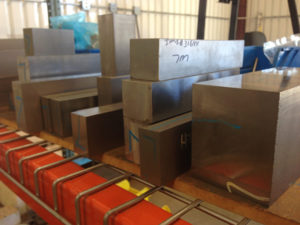Vortex® is a sintered, porous metal that is heat treated to 43 HRc with porosity of 25% air by volume. A system of interconnected pores with an average diameter of 7 (.0003″) microns is dispersed throughout the Vortex® material. Using Vortex® in appropriate areas, eliminates gas buildup, reduces injection pressure, lowers cycle times, gloss levels and substantially reduces scrap and reject rates.

General Properties
Average pore size: 7 microns
Porosity: 25% air by volume
Linear Expansion: (@20-150C) 6.67-6.94 in/in F
Heat transfer co-efficient (at room temperature): 16.93-19.35 BTU/ft. hr. F
TR: 834 MPa ; Hardness: 43 HRc
HSS Machinability: Good
Machining and Polishing
Vortex® can be machined by conventional methods using cutoff saws, end mills, grinders, EDM methods, stoning, etc. It is important to remember that this material is honeycombed with thousands of microscopic holes which are affected by metal removal. Oil coolant is recommended.
Grinding and milling closes the pores of this porous steel.
Stoning, using a back and forth/side method is possible to achieve a better finish, however, the surface must first be EDM burned. Stoning and polishing, up to about a number 600 stone/paper finish, is possible. During the stoning and polishing process, it is important to occasionally flush the pores at the surface to prevent packing the pores with debris.
Electric Discharge Machining is the best way to re-establish permeability.
This method will burn away the metal fragments that are crushed over the pores by milling and or grinding. Because of its powdered metal origin, when using a wire EDM machine, it is important to increase the wire speed about 10% to prevent arcing from the particles produced. Because a wire EDM machine uses water, the insert must be dried in an oven after EDM, or rust and pore closer will ensue.
Machining Vortex®
Vortex® is 20-30% porosity by volume and will give false or misleading readings if tested with either Rockwell or Brinell hardness tester. As the load of either of these testers is applied, the pores beneath the surface will collapse and render a false reading. It is recommended that a micro Vickers hardness tester (50 or 30g. load) be used to test the hardness of Vortex®.
Vortex® can be textured. In order to prevent the possibility of destroying the internal vent structure of the material, certain procedures must be strictly adhered to.
The pores of the material must be thoroughly cleaned and properly sealed prior to texturing. Failure to do so results in the etchants used in the texturing process leaching into the pore structure and rusting the venting closed. This rust is permanent and cannot be removed once it has occurred. The piece will be useless and must be replaced.
It is imperative that the molder and / or mold maker’s texture source come supplied with the information needed to properly process the piece. We strongly advise against inserting the Vortex® into an already textured surface. The perfect venting of Vortex® results in high resolution of grain at the inserted are and the dramatic reduction in gloss. It is recommended that the entire textured surface be Vortex®. Please consult your graining source for more information.
Vortex® provides perfect venting of all gases from the mold. While this is a desirable in most case, the venting of the Vortex® produces a perfect “marriage” between the resin and the molding surface, thus producing a dull, matte finish. If Vortex® is used as an insert on the cavity side, the result will be two dissimilar appearances due to differences in gloss and texture definition. This may be acceptable if the parts are painted after molding.
Molder’s World, Inc. does not recommend running water through Vortex®, if at all possible. However, occasionally the need will arise, due to size or application considerations, to water-cool Vortex®. There are a number of ways to accomplish this. In designs that involve a straight-through water line pattern, a simple, effective way to seal the line and prevent leakage is electroless-nickel plate the water lines. In complex circuit-tupe patterns, it is advisable to use an acceptable sealant such as Dichtol. Electroless nickel has a tendency to pull away from the sharp corners such as those at intersections of crossing water lines. However minutely this pulling way from the corners may be, it will eventually cause some leakage into the material and reduce permeability through oxidation. Improper use of the Dichtol sealant will produce the same results. Regardless of which sealing process is used, be absolutely certain the material has been thoroughly cleaned of any residual machining fluids or other contaminants.
Cleaning, Maintenance and Resin Removal
There are two times cleaning must to be preformed to Vortex®:
The first time is when the tool shop has prepared the insert or cavity. The material is 25% air by volume and the cutting fluids will displace the air, thus filling and clogging the pores. After the permeability has been restored by EDM machining the venting surface, the steel should be sent out to be professionally cleaned.
The steel should be thoroughly blown dry through a drilled, tapped, and EDM-relieved hole in the side of the insert or cavity. This clean out or back-flush hole should be designed to accept a shop air fitting. This will be very useful over the life of the insert in back-flush fluid and future residue from the insert, and for checking restored permeability with filtered shop air. (See photo below.) If the cleaning operation is not completed, due to the trapped fluids, inside permeability will not exist.
The second time cleaning is needed is after the insert or cavity has been in operation and film, a thin layer of mold release agent, resin residue, shop oil or any other contaminate has partially or totally blocked the air flow. To clean the porous material, remove the insert or take the small cavity and send it out to be professionally cleaned.


